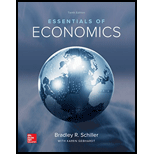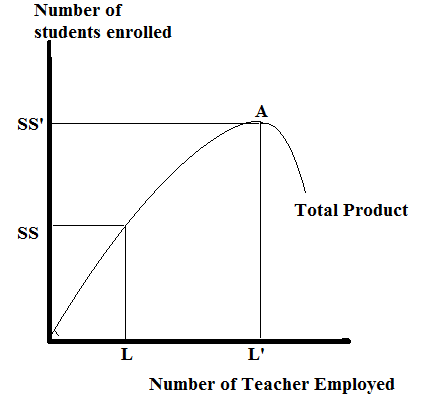
To analyze: the way a school can work with full capacity utilization.
Explanation of Solution
Production Function: It refers to the technological relationship between the quantity of a good produced and the factors of production used for producing the goods.
Providing educational service requires academic as well as non-academic staff as labor, school building (land) and capital for running school.
A teacher can efficiently teach only a limited number of students, if the strength of the class is large then there will be some inefficiencies in handling a large number of students. This process is explained by using the production function theory.
The inefficiency arising from larger strength is shown with the help of production function diagram is as follows:

In the above diagram, the number of students enrolled is shown along the vertical axis and the number of teachers employed is shown along the horizontal axis.
With the increase in the number of teachers employed, the number of student enrollment increases.
After the L’ unit of a teacher employed, the total product (number of student enrollment) starts falling after point A in the short run.
After point A, the ratio of the number of teachers employed and the number of students enrolled in school are not working with full efficiency.
To inhibit fuller capacity utilization, the school should operate at point A so the total product can maximize, and the school can inhibit fuller capacity utilization.
.Want to see more full solutions like this?
Chapter 5 Solutions
Essentials of Economics - Standalone book
- Analyze financial banking products from the Asset-Based Financial Products side (like credit cards, loans, mortgages, etc.). Examine aspects such as liquidity, risk, and profitability from a company and an individual point of view. Ensure that the interventions demonstrate analytical skills and clearly express the points of view regarding the topic.arrow_forwardprovide source where information was retrieved NAME OF SCHOOL: Florida Polytechnical college ADDRESS: PRIVATE OR PUBLIC: ENTRY REQUIREMENTS - GPA, SAT/ ACT SCORES: IN STATE TUITION COST: DORMITORY COST: OFF CAMPUS HOUSING OPTIONS: AVERAGE MONTHLY RENT FOR A ROOM in the area: MEAL PLAN: Do they have them? Are they mandatory for freshmen? How much $: CAMPUS SIZE: (don't put acres - is it a small, medium, or large campus?) TEACHER STUDENT RATIO/CLASS SIZE: NUMBER OF UNDERGRADUATE (freshmen, soph, junior, seniors) STUDENTS ON CAMPUS: FINANCIAL AID/SCHOLARSHIPS OPPORTUNITIES: ACCEPTANCE RATE: GRADUATION RATE: ONLINE OPTION? BUSINESS DEGREES: (list them) ACADEMIC SUPPORT - TUTORING: JOB PLACEMENT/CAREER SERVICES: what % of students get lined up with jobs right out of college with the school's help? INTERNSHIP OPPORTUNITIES: Paid? Unpaid? STUDY ABROAD PROGRAMS: Do they exist? How much $? SPORTS: Competitive - D1, D2, D3, etc? Intramural? (non-competitive sports opportunities) CLUBS: How many?…arrow_forwardExplain the following: How is 4 to 5 a 22% increase? How is 100 to 80 a 22% decrease? Not pictured: How is 100 to 90 a 11% decrease? How is 100 to 50 a 67% decrease?arrow_forward
- Without Trade Production Consumption With Trade Production Everglades Denali Shorts (Millions of Almonds Shorts Almonds pairs) (Millions of pounds) (Millions of pairs) (Millions of pounds) 12 16 5 30 12 16 5 30 64 0 0 20 Trade action Imports 13 ▼ Exports 39▾ Imports 13 ▼ Exports 39 Consumption Gains from Trade Increase in Consumptionarrow_forwardPractice: Their labor forces are each capable of supplying four million hours per week that can be used to produce shorts, almonds, or some combination of the two. Country Shorts Almonds (Pairs per hour of labor) (Pounds per hour of labor) Everglades 4 16 Denali 5 10 Suppose that initially Denali uses 1 million hours of labor per week to produce shorts and 3 million hours per week to produce almonds, while Everglades uses 3 million hours of labor per week to produce shorts and 1 million hours per week to produce almonds. As a result, Everglades produces 12 million pairs of shorts and 16 million pounds of almonds, and Denali produces 5 million pairs of shorts and 30 million pounds of almonds. Assume there are no other countries willing to engage in trade, so, in the absence of trade between these two countries, each country consumes the amount of shorts and almonds it produces. Everglades's opportunity cost of producing 1 pair of shorts is4 pounds of…arrow_forwardQuestion #1. The Governor's budget Announcement from Decenbrer 2024. Review proposed resources for understanding the Governo's proposed FY25 Budget, provide a reflection focusing on initial thoughts and feeling on the prpposed budget for the state. Please provide APA citiatiion?arrow_forward
- #3. The Governor's Budget Announcement from December 2024. Review proposed resources for understanding the Governo's proposed FY25 Budget. Does the Governor's proposed budget impact the current Welfare State, Why or Why not?arrow_forward3. Which is faster, red or green cars? You are a purchasing manager at a large car dealership in a busy urban area. You purchase on average 250 cars monthly for the dealership. People are buying new and used cars from your dealership regularly, and business is doing well. Most of your customers are average middle-income households, and they typically purchase bigger cars that are pricey. Your boss, Natalya, invited you for lunch to discuss the next big purchase in preparation for the big Summer sales event. While chatting about the business, Natalya told you the following: "While surfing social media today, I read a government report that says the economy is growing and inflation is rising. As the economy continues to grow due to an increase in consumption by consumers, the prices are expected to rise to a higher level than usual. The report also said that the increase in consumption has caused a shortage in the auto industry, which I think might be good for us (or bad, I don’t know.)…arrow_forward1. Homemade Lasagna and the Pursuit for Knowledge Your sister, Jamila, a newly appointed human resource manager at a fast-growing assisted living facility, was sitting with you at the dinner table. While you were enjoying a homemade Lasagna and watching TV together, a news report stated that "According to government officials, we are now headed into a recession that could last up to 10 months. The decline in economic activities is expected to affect all major industries." Your sister raised her eyebrows and showed an expression of confusion as she looked at you and stated, "Oh dear, what should I do now as an HR manager? My company is opening a large facility in a couple of months, and we need at least 60 people to run it. I oversee finding those people, but now I am afraid of doing so because it looks like the economy is in trouble. So, dear brother, help me understand a couple of things:" First, what on earth is a “recession”, and how does it affect the economy? Do things become…arrow_forward
- Consider the simple discrete job search model that we studied in class. Only the unemployed can receive one offer per period from F(w) that is a uniform distribution on [0,2]. There is a constant probability of being laid off at the end of each period while employed. Assume that she can get a new offer right away when laid off. We want to understand the reservation wage, WR, in this model. Assume that u(c) = c. The parameters are a discount factor ẞ and an unemployment benefit b.R and show that T is contraction on [0, ∞). Explicitly state any additional assumptions that you may need.(Grading guide line: 5pt for the exact form of T, 10pt for showing contraction, and 5pt for stating correct assumptions.)< (b) Discuss why (a) is useful to understand the reservation wage wд in this economy.< (c) We write WR = WR (b,ẞ,λ) to reveal its dependence on (b,ẞ,λ). Show that 0 ≤ aWR дь OWR дл ≤1 and ≥0. What about ? awR ав State any additional assumptions that you may need.< (d) Briefly explain the…arrow_forward3. Consider the market for paper. The process of producing paper creates pollution. Assume that the marginal damage function for pollution is given by: MDF = 3E where damages are measured in dollars and E is the level of emissions. Assume further that the function describing the marginal abatement cost of emissions is given by MAC 120-E where benefits are measured in dollars and E is the level of emissions. a. Graph the marginal damage function (MDF) and the marginal abatement cost function (MAC). b. What is the unregulated level of emissions Eu? What is the social welfare of this emissions level? c. Assume an existing emission quota limits emissions to E = 60. Show on the graph why this policy is inefficient. What is the deadweight loss caused by this policy?arrow_forwardshow written calculation for Barrow_forward
 Managerial Economics: Applications, Strategies an...EconomicsISBN:9781305506381Author:James R. McGuigan, R. Charles Moyer, Frederick H.deB. HarrisPublisher:Cengage Learning
Managerial Economics: Applications, Strategies an...EconomicsISBN:9781305506381Author:James R. McGuigan, R. Charles Moyer, Frederick H.deB. HarrisPublisher:Cengage Learning


 Managerial Economics: A Problem Solving ApproachEconomicsISBN:9781337106665Author:Luke M. Froeb, Brian T. McCann, Michael R. Ward, Mike ShorPublisher:Cengage Learning
Managerial Economics: A Problem Solving ApproachEconomicsISBN:9781337106665Author:Luke M. Froeb, Brian T. McCann, Michael R. Ward, Mike ShorPublisher:Cengage Learning Economics (MindTap Course List)EconomicsISBN:9781337617383Author:Roger A. ArnoldPublisher:Cengage Learning
Economics (MindTap Course List)EconomicsISBN:9781337617383Author:Roger A. ArnoldPublisher:Cengage Learning





